There are 11 different types of frogs in Connecticut. The majority of frogs are toads and true frogs, with only two tree frogs in the state. Frogs live in various habitats and can be easily found when you know where to look.
Some are active in the day, while others are nocturnal. On this list, you learn about all 11 species of frogs in Connecticut and useful facts to know about each one.
Water sources are common in areas that frogs live, as most species rely on moisture to live. They also use fresh water to breed, and can even lay eggs in your swimming pool.
Let’s go over all of the frog species found in these states to help you on your next adventure. Some species will also make good pets, and you should learn about them thoroughly to take care of the best.
Here are all 11 species in Connecticut, where they live, and valuable facts to know about each one:
Table of Contents
Frogs in Connecticut
1. American Toad

- Experience Level: Beginner
- Family: Bufonidae
- Scientific Name: Anaxyrus americanus
- Other Names: Eastern American toad
- Adult Size: 2 to 3.5 inches
- Lifespan: 2 to 10 years
- Average Price Range: $20 to $30
American toads are native to North America, more common in the southern United States. They will live near semi-permanent water to breed. Areas with a high insect population are where they are more common.
They are nocturnal and will hide in vegetation and under other natural debris during the day. This species is active from spring to fall and dig underground to hibernate during winter.
Brown, reddish-brown, and olive are the colors they are found in. They are primarily multicolored, but some are solid. American toads have dark spots on their back, with one or two warts inside, which helps us distinguish them from other toads.
Their back and legs are covered in warts and pale bellies. Their back feet have five toes which are used for digging.
American toads eat insects, spiders, worms, and other invertebrates. As many as 1,000 insects can be eaten by this species regularly.
Like other amphibians, they do not need to drink water but absorb it through their skin. They usually do not live for more than two years in the wild, but when kept as a pet, they can have a long lifespan lasting around a decade.
2. Fowler’s Toad
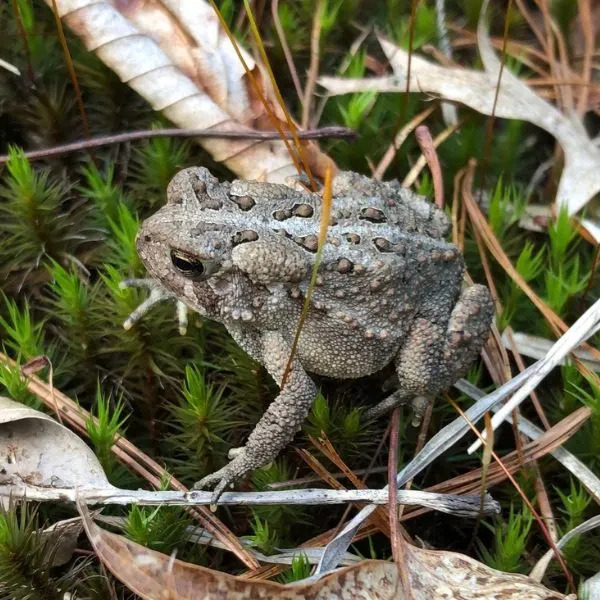
- Experience Level: Beginner
- Family: Bufonidae
- Scientific Name: Anaxyrus fowleri
- Other Names: Bufo fowleri
- Adult Size: 2 to 3 inches
- Lifespan: 2 to 10 years
- Average Price Range: $10 to $20
Fowler’s toads live in the eastern U.S and can be found in the coastal regions of Connecticut. They inhabit woodlands, meadows, forests, and beaches.
Soil substrate is preferred in their habitat to make it easier for them to burrow. After hibernating in the winter, they will emerge around late April. Breeding occurs around a month after their rest and happens in ponds, and other shallow freshwaters.
The fowler’s toad is very similar to the American toad but has three warts on its dark spots instead of two. They can be brown, gray or greenish, and have rough, bumpy skin.
Parotid glands appear around their eyes, and their stomach is a pale white. Males have a vocal sack under their throat to call females or communicate with other toads.
This toad can be active at night or day. They feed on insects and other small invertebrates. Their paratoid gland releases toxins to make them less palatable for predators to eat.
Raccoons and snakes are some of the species that will eat this toad. They spend a lot of their time in their burrows and will go in them to avoid extreme temperatures.
3. American Bullfrog
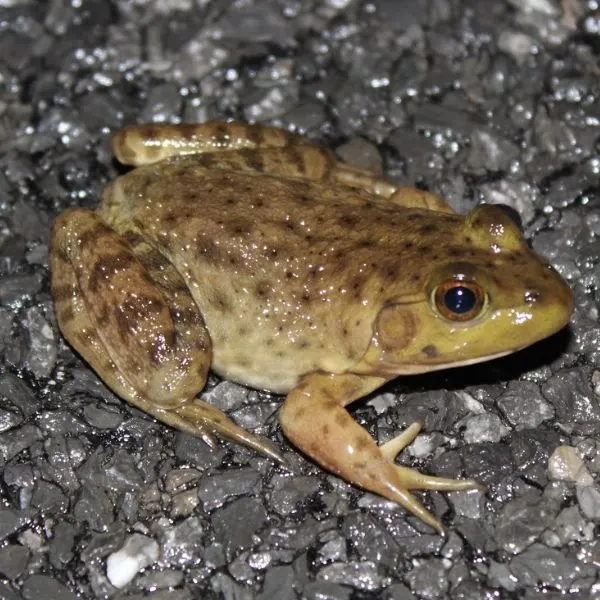
- Experience Level: Intermediate to Advanced
- Family: Ranidae
- Scientific Name: Lithobates catesbeianus
- Other Names: lithobates catesbeianus
- Adult Size: 3.5 to 8 inches
- Lifespan: 7 to 15 years
- Average Price Range: $20
American bullfrogs can be found all over the U.S and are very common in Connecticut. Freshwater habitats like lakes or streams are where they live. Permanent freshwater is preferred for this species.
They are mostly active during the warmer months. In winter, they will hibernate and will bury themselves in mud or ponds. After hibernation, they will breed, and females can lay as much as 20,000 eggs.
Bullfrogs are one of the largest species of frogs in America and the world. The largest can grow up to 8 inches, and the largest of this species can weigh over 1 pound.
They are green to yellow-colored, and a large eardrum can be seen on the side of their head. Males have a yellow throat, and females’ throats are white. Their bellies are pale, and their feet are webbed to help with their aquatic lifestyle.
Bullfrogs are one of the largest species of frogs and will eat anything they can overpower. Other frogs, turtles, fish, birds, and bats are some of the prey that they feed on.
Humans will eat bullfrogs for their legs, and they are one of the most consumed frog species. Their size makes them one of the most dominant species in the waters where they live.
4. Green Frog

- Experience Level: Beginner
- Family: Ranidae
- Scientific Name: Lithobates clamitans
- Other Names: NorthernGreen Frog
- Adult Size: 2.25 to 5 inches
- Lifespan: 16 to 20 years
- Average Price Range: $10
The green frog is a common frog in Connecticut and the eastern half of the U.S. They live in aquatic habitats like lakes, streams, and marshes. They spend most of their time in or near water.
In spring, they will breed, and females will lay eggs in water. In winter and cold periods, they will hibernate underwater or in mud. You will more likely see this frog at night since they are most active.
Green frogs look similar to bullfrogs but are smaller. They are green or brown with a mottled pattern on their back. A large circular eardrum is exposed on the side of their head. Their bellies are white, and males will have yellow coloring under their throats.
They will jump in the water to escape any potential predators and make a screaming sound when approached. Larger frogs, snakes, and birds are some of the species that will prey on this species. Green frogs eat insects but will also eat anything they can swallow.
5. Pickerel Frog
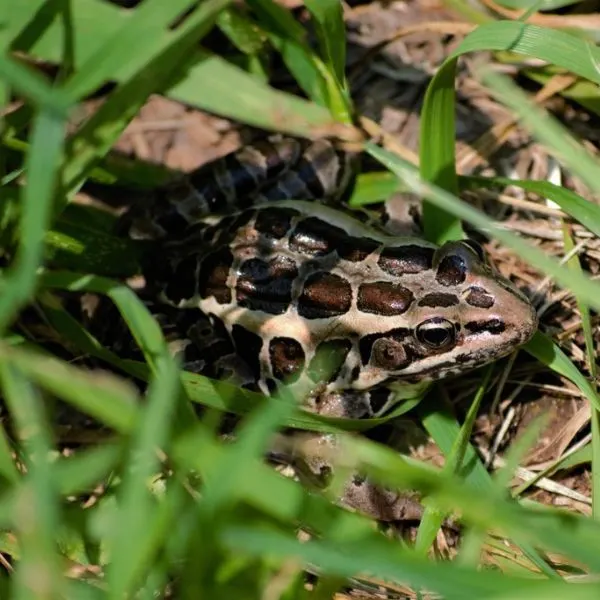
- Experience Level: Intermediate
- Family: Ranidae
- Scientific Name: Lithobates palustris
- Other Names: Rana palustris
- Adult Size: 1.75 to 3 inches
- Lifespan: 5 to 8 years
- Average Price Range: $10 to $15
Pickerel frogs live throughout Connecticut and the eastern United States. They live in meadows, marshes, and woodlands. They prefer wet habitats with a large amount of thick vegetation.
They are nocturnal and are active during the warmer seasons of the year. In winter, they will hibernate and bury themselves in the mud. Breeding occurs in spring, and around 3,000 eggs are laid in water.
Pickerel frogs look similar to the leopard frog. They have brown to yellowish skin with dark square blotches covering their back. In between their legs is orange or yellow coloring. Pickerel frogs have long legs and limbs.
This species can secrete a toxin from their skin to poison predators. Some other frog species like bullfrogs or green frogs can eat this species. The pickerel frog only lives in habitats with clean waters. Pollution will affect this species more than others.
6. Atlantic Coast Leopard Frog
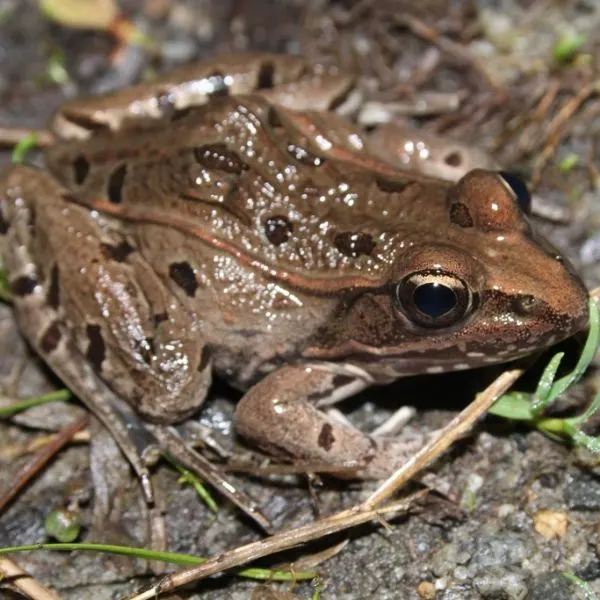
- Experience Level: Intermediate to Advanced
- Family: Ranidae
- Scientific Name: Lithobates kauffeldi
- Other Names: N/A
- Adult Size: 2 to 3.5 inches
- Lifespan: 2 to 5 years
- Average Price Range: N/A
Atlantic coast leopard frogs are a species of leopard frog that can be found in Connecticut.
They live in wetlands, marshes, meadows, and other habitats with slow-moving waters. They enjoy highly vegetated habitats, and it was originally thought to be the same species as the southern leopard frog.
Atlantic Coast leopard frogs are green or mint gray. They are covered in dark blotches on their back.
A yellow line runs from their snout to their rear. They have a rounded snout and an exposed eardrum on the side of their head. This species will change its color slightly to better blend in with its environment.
Like other frogs, this species is a carnivore, and they feed on beetles, worms, flies, and other small invertebrates. Birds and bullfrogs are their most common predator.
This species was discovered in 2012, so fewer studies have been done about this leopard frog species.
7. Northern Leopard Frog
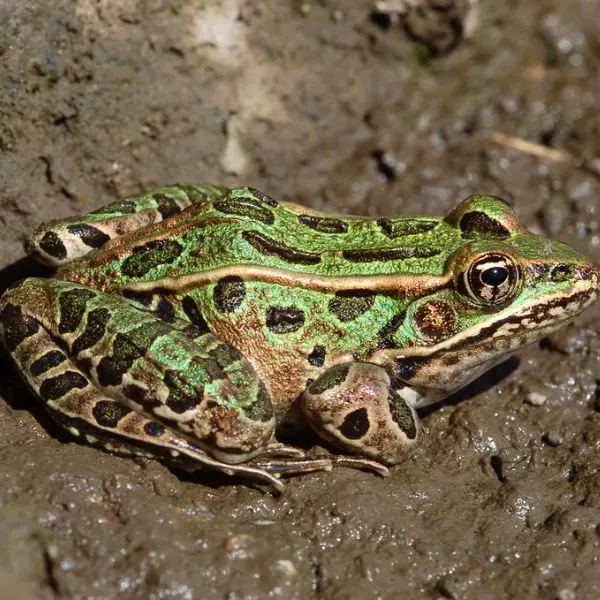
- Experience Level: Beginner
- Family: Ranidae
- Scientific Name: Lithobates pipiens
- Other Names: Rana pipiens
- Adult Size: 3.5 to 4.5 inches
- Lifespan: 2 to 4 years
- Average Price Range: $10 to $15
Northern leopard frogs are a common species in North America and are also found in Connecticut. They are found along the Connecticut River and other moist habitats.
Meadows, florists, and floodplains are some of the habitats they live in. They are found in water in spring but will move onto land during summer. Winter is when this species is not found since they hibernate.
Northern leopard frogs are named after the tan leopard blotches that cover their back. Their coloring can be green, brown, tan, or olive.
It is rare, but some frogs will have no spots on their back. A pale color ridge runs down the sides of their body. Northern leopard frogs have long legs that help them jump and escape predators.
Snakes, otters, and birds are the main predators this species faces. They feed on insects, other frogs, and other small species of animals. In Connecticut, they are listed as a species of Special Concern since they have a low population.
8. Eastern Spadefoot Toad

- Experience Level: Beginner
- Family: Scaphiopodidae
- Scientific Name: Scaphiopus holbrookii
- Other Names: The spadefoot toad
- Adult Size: 1.75 to 2.25 inches
- Lifespan: 2 to 10 years
- Average Price Range: $10 to $20
Eastern spadefoot toads live in the southern United States and parts of Connecticut. They live in near sandy soils to make it easier for them to burrow.
This frog will use temporary water sources for breeding, and when not breeding it will spend most of its time underground. They are active from spring to fall and will hibernate in the winter.
Brown, gray, black, or common colors of this species. They have smooth skin with no warts. Their back foot has a black sickle-shaped spade, which they use to dig, and also gives them their name. Their eyes are large and yellow, with cat-like ellipticals.
At night, hunting is also when this species will go out of its burrow. They feed on insects and other small invertebrates. One feeding can keep them sustained in their burrows for a few days.
9. Wood Frog
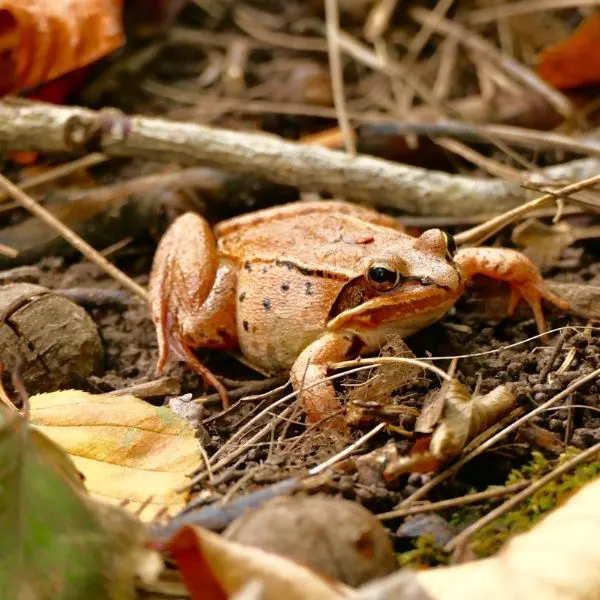
- Experience Level: Beginner
- Family: Ranidae
- Scientific Name: Lithobates sylvaticus
- Other Names: Rana sylvaticus
- Adult Size: 1.375 to 2.75 inches
- Lifespan: 1 to 3 years
- Average Price Range: $15 to $30
Wood frogs can be found in Connecticut and live in various freshwater habitats. Woodlands next to swamps, marshes, and pools are some of the places they live.
Breeding occurs in water, and during the summer, they spend more time on land. Wood frogs are primarily active and seen during the day. They have high cold resistance and can survive freezing temperatures in the winter when they hibernate.
Wood frogs are brown or tan. They have a dark marking on their face that looks similar to a mask. Depending on their environment, they can change their color to fit better in their habitat. They use their brown color to blend into leaf litter and wood.
Wood frogs are a small species, so they feed on small insects and invertebrates. They are the only frog species capable of living in the arctic circle. Snakes and predatory animals are what feed on this species.
10. Gray Treefrog
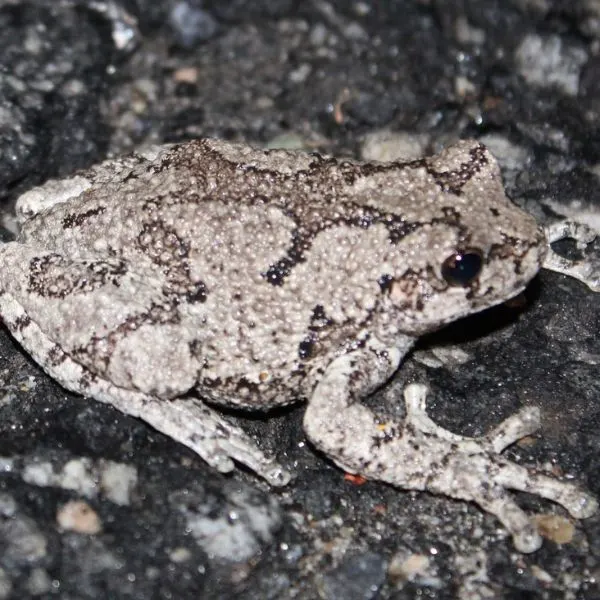
- Experience Level: Beginner to Intermediate
- Family: Hylidae
- Scientific Name: Dryophytes versicolor
- Other Names: Northern Gray Treefrog
- Adult Size: 1.25 to 2 inches
- Lifespan: 7 to 9 years
- Average Price Range: Around $20
Gray tree frogs are small species found in the eastern U.S and Connecticut. They are seen through the states and live in wooded areas next to a water source.
They will spend most of their time in trees but will come down to breed in fishless waters. In winter, they will hibernate underground and will sometimes freeze.
This species is gray or green with a mottled pattern on its back. They are nearly identical to the Copes gray tree frog. Grey tree frogs have blotches covering their back and yellow coloring between their eyes.
They can change their shade to help them blend in better with their environment. They have a pattern similar to tree bark.
Insects are the main things these species eat. They are nocturnal and will come out at night to hunt.
To avoid predators like sandals, birds, and other frogs, they will spend their time hiding under logs and natural debris.
11. Spring Peeper

- Experience Level: Intermediate
- Family: Hylidae
- Scientific Name: Pseudacris crucifer
- Other Names: Spring peeper
- Adult Size: 0.75 to 1.25 inches
- Lifespan: 2 to 4 years
- Average Price Range: $10 to $20
Spring peepers live in the eastern united states and can be found in different moist habitats within Connecticut. This species lives in forests, fields, and even residential areas.
They are even able to live in brackish waters. In spring, this species will breed and lay their eggs attached to vegetation underwater.
The spring peeper will hibernate in winter and is one of the first species to emerge after hibernation. Their call is high-pitched and is usually the sign of spring.
Spring peepers are a small species that is tan or brown. They have blotches on their back, and their pattern helps them blend into trees. An X pattern sits on the spring peeper’s head, which helps identify this species. Their feet also have toe pads that help them climb.
At night is when this species is most active and hunts. They feed on ants, flies, spiders, beetles, and other small invertebrates. Spring peepers have a healthy population in the range they inhabit. Habitat loss of wetlands is the main threat this species faces.
Wrapping up
There are 11 species of frogs in Connecticut that can be found all over the state. Most will live in similar habitats, and near each other, since Connecticut is one of the smallest states in the U.S. Even though there are only 11 species, they are still an important part of the environment.
Frogs help keep a balanced ecosystem and are a sign of a healthy population. Today frogs and other amphibians have been on the decline, and some are becoming closer to extinction.
Habitat loss, disease, and pollution are some of the reasons that frogs have been slowly declining in population.
Keeping the environment clean and maintaining their habitat is one of the best ways to protect local species. Frogs use water sources for breeding and why keeping the waterways clean is vital to their survival.
Hopefully, this list is helpful in learning about the 11 species in Connecticut and how they live. There are over 5,000 species of frogs in the world, and Connecticut has just a small amount to appreciate.
Frogs in other states
